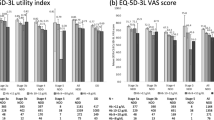Abstract
It is widely thought that patients with end-stage renal disease who remain vocationally active and/or commercially insured following dialysis initiation have better clinical outcomes and higher quality of life than those who do not. However, scientifically robust data are lacking. Here, we examined whether vocational status (active, N = 1848; inactive, N = 10,001) and, separately, insurance status (commercial, N = 4858; Medicare/self-pay, N = 13,329; Medicaid, N = 3528) were associated with clinical outcomes and Kidney Disease Quality of Life (KDQOL) scores among a cohort of patients who initiated dialysis at a large US dialysis organization during 2015–2016. Outcomes were considered from the day after index (31 days after dialysis initiation for vocational status and 1 day after initiation for insurance status) until the earliest of death, discontinuation of dialysis, transplant, loss to follow-up, or end of study (30 September 2016). Comparisons were made using intention-to-treat principles and generalized linear models adjusted for imbalanced patient characteristics, including sociodemographic variables. Vocational inactivity (vs. vocational activity) was independently associated with higher rates of mortality and hospitalization, lower rates of transplant, and lower KDQoL scores in 4 of 5 domains. Similar trends were observed when comparing Medicare/self-pay or Medicaid insurance to commercial insurance. Vocational activity, and separately, commercial insurance, were independently associated with better clinical and quality of life outcomes compared to other insurance and vocational categories. These findings may inform patient and physician education, and guide advocacy efforts.


Similar content being viewed by others
References
Marmot M (2001) Inequalities in health. N Engl J Med 345(2):134–136
Marmot M, Friel S, Bell R, Houweling TA, Taylor S (2008) Closing the gap in a generation: health equity through action on the social determinants of health. Lancet 372(9650):1661–1669
Drey N, Roderick P, Mullee M, Rogerson M (2003) A population-based study of the incidence and outcomes of diagnosed chronic kidney disease. Am J Kidney Dis 42(4):677–684
Merkin SS, Coresh J, Diez Roux AV, Taylor HA, Powe NR (2005) Area socioeconomic status and progressive CKD: the Atherosclerosis Risk in Communities (ARIC) Study. Am J Kidney Dis 46(2):203–213
Merkin SS, Diez Roux AV, Coresh J, Fried LF, Jackson SA, Powe NR (2007) Individual and neighborhood socioeconomic status and progressive chronic kidney disease in an elderly population: the cardiovascular health study. Soc Sci Med 65(4):809–821
Imanishi Y, Fukuma S, Karaboyas A, Robinson BM, Pisoni RL, Nomura T, Akiba T, Akizawa T, Kurokawa K, Saito A, Fukuhara S, Inaba M (2017) Associations of employment status educational levels with mortality hospitalization in the dialysis outcomes practice patterns study in Japan. PLoS One 12(3):e0170731
Sandhu GS, Khattak M, Pavlakis M, Woodward R, Hanto DW, Wasilewski MA, Dimitri N, Goldfarb-Rumyantzev A (2013) Recipient’s unemployment restricts access to renal transplantation. Clin Transplant 27(4):598–606
The United States Renal Data System 2016 Annual Data Report: Atlas of End-Stage Renal Disease in the United States, 2016, National Institutes of Health, National Institute of Diabetes and Digestive and Kidney Diseases, Bethesda
Feder J, Nadel MV, Krishnan M (2016) A matter of choice: opportunities and obstacles facing people with ESRD. Clin J Am Soc Nephrol 11(3):536–538
Muehrer RJ, Schatell D, Witten B, Gangnon R, Becker BN, Hofmann RM (2011) Factors affecting employment at initiation of dialysis. Clin J Am Soc Nephrol 6(3):489–496
Kutner NG, Zhang R, Huang Y, Johansen KL (2010) Depressed mood, usual activity level, and continued employment after starting dialysis. Clin J Am Soc Nephrol 5(11):2040–2045
Dooley D, Fielding J, Levi L (1996) Health and unemployment. Annu Rev Public Health 17:449–465
Goldman DP, Smith JP (2002) Can patient self-management help explain the SES health gradient? Proc Natl Acad Sci USA 99(16):10929–10934
National Center for Healthcare Statistics. Health Insurance and Access to Care. NCHS Fact Sheet 2017. https://www.cdc.gov/nchs/data/factsheets/factsheet_hiac.pdf. Accessed 19 July 2017
Acknowledgements
We acknowledge the helpful contributions of all members of the Healthcare Analytics and Insights team at DaVita Clinical Research. We also acknowledge informative conversations with Daniel Galemba of DaVita, Inc. An abstract describing this work was accepted for presentation at the American Society for Nephrology Kidney Week, New Orleans, LA, November 2–5, 2017.
Author information
Authors and Affiliations
Corresponding author
Ethics declarations
Conflict of interest
This work was supported by DaVita, Inc. All of the authors are current or former employees of DaVita Clinical Research. SMB’s spouse is an employee of AstraZeneca.
Research involving human participants and/or animals
This retrospective study was conducted using deidentified patient data. As such, it was deemed exempt from institutional review board or ethics committee approval. No research involving animals was performed.
Informed consent
Because the study was conducted using deidentified patient data, informed consent was not required. We adhered to the Declaration of Helsinki.
Rights and permissions
About this article
Cite this article
Luo, J., Lee, A., Cohen, D.E. et al. Vocational activity and health insurance type among patients with end-stage renal disease: association with outcomes. J Nephrol 31, 577–584 (2018). https://doi.org/10.1007/s40620-018-0478-2
Received:
Accepted:
Published:
Issue Date:
DOI: https://doi.org/10.1007/s40620-018-0478-2




